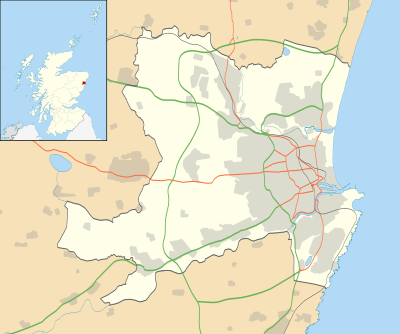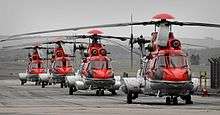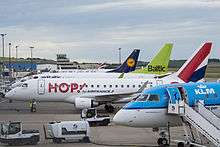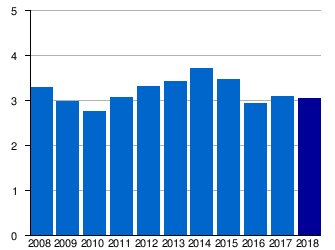Aberdeen Airport
Aberdeen International Airport (Scottish Gaelic: Port-adhair Eadar-nàiseanta Obar Dheathain) (IATA: ABZ, ICAO: EGPD) is an international airport, located in the Dyce suburb of Aberdeen, Scotland, approximately 5 nautical miles (9.3 km; 5.8 mi) northwest of Aberdeen city centre. A total of just under 3.1 million passengers used the airport in 2017, an increase of 4.6% compared with 2016.
Aberdeen International Airport Port-adhair Obar Dheathain | |||||||||||||||||||
|---|---|---|---|---|---|---|---|---|---|---|---|---|---|---|---|---|---|---|---|
| Summary | |||||||||||||||||||
| Airport type | Public | ||||||||||||||||||
| Owner | AGS Airports | ||||||||||||||||||
| Operator | Aberdeen International Airport Ltd. | ||||||||||||||||||
| Serves | Aberdeen | ||||||||||||||||||
| Location | Aberdeen, Scotland, UK | ||||||||||||||||||
| Opened | July 28, 1934 | ||||||||||||||||||
| Elevation AMSL | 215 ft / 66 m | ||||||||||||||||||
| Coordinates | 57°12′09″N 002°11′53″W | ||||||||||||||||||
| Website | www | ||||||||||||||||||
| Map | |||||||||||||||||||
 EGPD Location of airport in Aberdeen | |||||||||||||||||||
| Runways | |||||||||||||||||||
| |||||||||||||||||||
| Helipads | |||||||||||||||||||
| |||||||||||||||||||
| Statistics (2018) | |||||||||||||||||||
| |||||||||||||||||||
The airport is owned and operated by AGS Airports which also owns and operates Glasgow and Southampton airports. It was previously owned and operated by Heathrow Airport Holdings (formerly known as BAA). Aberdeen Airport is a base for Eastern Airways and Loganair. The airport also serves as the main heliport for offshore North Sea oil and gas industry. With the utilisation of newer aircraft, helicopters can reach northernmost platforms on both the east and west of Shetland.
The airport has one main passenger terminal, serving all scheduled and charter holiday flights. In addition, there are four terminals dedicated to North Sea helicopter operations, used by Bristow Helicopters, CHC Helicopter, NHV and Babcock Mission Critical Services Offshore. Bristow Helicopters also have a small terminal adjacent to the main passenger terminal, used primarily for oil company charter flights to Sumburgh in Shetland, operated by Eastern Airways.
History
Early years
The airport opened on 28 July.1934.[3] It was established by Eric Gandar Dower for his other new enterprises including Aberdeen Flying School, Aberdeen Flying Club, and his airline, Aberdeen Airways.[4]
During Second World War the airfield became a Royal Air Force station known as RAF Dyce. It was the site of the Dyce Sector Operations Room within No. 13 Group RAF. Although fighter aircraft were based there throughout the Battle of Britain to provide protection from German bombing raids from Occupied Norway, it was mainly used as a photographic reconnaissance station. Anti-shipping operations by RAF Coastal Command were carried out from RAF Dyce as well as convoy escort. The airfield was bombed by the Luftwaffe on 26 July 1940 and 27 August 1940, however no damage was reported. A decoy site ('Q' Site) was located at Harestone Moss near Whitecairns. The aim of this site was to create the impression of an active airfield during the night. The decoy worked on around four occasions, where several raids resulted in bombs being dropped on the decoy site. The decoy site had a small underground bunker that housed a generator. This was used to power a decoy 'flarepath' in addition to a rotating lamp to give the impression of a taxiing aircraft. Near the airport off the A96 road, to deter German gliders landing to attack RAF Dyce, the flat areas across from Concraig Farm (between Blackurn and Kintore) had wooden poles erected as anti-glider landing poles. A Spitfire IIa crashed at the east side of the airfield on 19 November 1941 during attack practice with a target glider being towed. F/O Zaoral is buried in the old Dyce graveyard, where some German aircrew are also buried that crashed in Aberdeen in 1940.
A significant wartime event occurred in May 1943 when a German Junkers Ju 88 night-fighter landed at Dyce; it was flown to Scotland by its crew, who wanted to defect to the Allies.[5] The surrender of this aircraft was of great intelligence value at the time, as it was fitted with the latest FuG 202 Liechtenstein BC A.I radar. The aircraft survives and is displayed in the RAF Museum in London.[5]
On 17 August 1943, a Mosquito crashed following a stall in the circuit, crashing onto 5 John Street in Dyce village; another Mosquito on 10 April 1944 crashed on approach to the airfield. On 26 December 1944, A Messerschmitt BF109G signalling intentions to surrender crash landed at the airfield. On 16 May 1945, two pilots were killed when a Wellington bomber crashed on landing wrecking a goods train in Dyce railway station. During air-raids in the Second World War, aircraft were moved to East Fingask beside Oldmeldrum. One RAF building still remains at East Fingask, where aircrews waited for the "All Clear" before returning to Dyce airfield.
The following units have been based at Aberdeen Airport:[6]
- No. 1 Coastal Patrol Flight RAF
- No. 2 Radio Servicing Section RAF
- No. 4 Fighter Command Servicing Unit RAF
- No. 5 Gliding School RAF
- No. 7 Maintenance Unit RAF
- No. 8 (Coastal) Operational Training Unit RAF
- No. 9 Blind Approach Training Flight RAF
- No. 662 Gliding School RAF
- No. 663 Gliding School RAF
- No. 1509 (Beam Approach Training) Flight RAF
- No. 2737 Squadron RAF Regiment
- No. 2784 Squadron RAF Regiment
- Aberdeen University Air Squadron
Post RAF use

Virtually nothing remains from the war era at the airport due to expansion and development of the industrial estates around it. The original airport terminal was located at the east side where the Bond Offshore Helicopters Terminal 2 is located, a new terminal was built along with a new control tower to handle the increase in air traffic. The airport was nationalised in 1947 and was transferred to the control of the British Airports Authority (BAA) in 1975.[7] From 1967 and 1970 there were regular flights to Moscow and Toronto; these were later stopped due to cost related problems.
With the discovery of North Sea oil, helicopter operations began in 1967, linking the growing number of oil platforms to the mainland. As Aberdeen became the largest oil-related centre in Europe, the airport became the world's largest commercial heliport. Today, Aberdeen Airport handles more than 37,000 rotary wing movements carrying around 468,000 passengers annually. Helicopters account for almost half of all aircraft movements at the airport.
Development since the 2000s

Until March 2005, aircraft were not allowed to take-off or land between 22:30 and 06:00 local time due to noise constraints. The city council overturned this ban, however, despite some Dyce residents' objections, and the airport is now open 24 hours a day to fixed-wing aircraft[8] with a quota count of QC4 or below, and the overnight restrictions still apply to helicopters.[1]
General aviation flight training for private pilots licences takes place from the east side of the airport. Signature Flight Support also handles most of the private flights and corporate jets that park on the Eastside Apron. An air ambulance (fixed wing) is positioned on the eastside in a dedicated hangar, Gama Aviation operates the Super King-Air aircraft. There is an additional air ambulance Eurocopter EC135 helicopter based at the airport for use during daylight hours to attend emergency incidents.
Aberdeen, being a major city in the oil industry has a number of oil company charter flights, these have included flights to South America and also Korea (via Abu Dhabi). Flights from the USA are regular visitors and the occasional military flights have also landed.
On 6 October 2011, a 124-metre extension to the main runway at the airport was opened, almost eight months ahead of schedule.[9] On 8 January 2013, the airport was renamed Aberdeen International Airport.[10]
In October 2014, Heathrow Airport Holdings reached an agreement to sell the airport, together with Southampton and Glasgow, to a consortium of Ferrovial and Macquarie Group for £1 billion.[11] The airport handles around 500,000 passengers per year by helicopter for the North Sea oil fields.[12] making it the world's busiest heliport.[13]
A total of just under 3.1 million passengers used the airport in 2017, an increase of 4.6% compared with 2016.[2] The airport's Master Plan 2013 forecast growth to 5.09 million passengers a year by 2040.[14][1] A major three-year project (2016-2019) aims to transform the passenger terminal and increase space by 50%.[15]
In 2019 the airport was ranked worst in Scotland and sixth worst in the UK by Which? magazine in a ranking of 30 airports for customer satisfaction, with a score of 50%.[16] Edinburgh performed better on 61% while Glasgow International achieved the top rank in Scotland at 64%. In February, Easyjet cut its Aberdeen to Gatwick service.[17]
Airlines and destinations
Passenger
| Airlines | Destinations |
|---|---|
| Aer Lingus Regional | Dublin |
| airBaltic | Seasonal: Riga |
| Air France Hop | Paris–Charles de Gaulle |
| BH Air | Seasonal: Burgas[18] |
| British Airways | London–Heathrow |
| DAT | Seasonal: Esbjerg[19] |
| Eastern Airways | Humberside, Southampton,[20] Teesside |
| easyJet | London–Luton Seasonal: Geneva |
| KLM | Amsterdam |
| Loganair | Belfast–City, Birmingham, Bristol, Esbjerg, Exeter,[21] Kirkwall, Manchester, Newcastle upon Tyne, Norwich,[22] Southampton,[23] Sumburgh |
| Ryanair | Alicante Seasonal: Faro, Málaga |
| Scandinavian Airlines | Copenhagen, Oslo–Gardermoen, Stavanger |
| TUI Airways[24] | Tenerife–South Seasonal: Corfu, Dalaman, Ibiza, Palma de Mallorca, Reus, Rhodes |
| Widerøe | Bergen, Stavanger |
| Wizz Air | Gdańsk |
Statistics
Passengers and movements
| Number of passengers[note 1] | Number of movements[note 2] | Aberdeen Airport passenger totals 2008–2018 (millions) | ||
|---|---|---|---|---|
| 2008 | 3,290,920 | 119,831 |  | |
| 2009 | 2,984,445 | 109,876 | ||
| 2010 | 2,763,708 | 102,396 | ||
| 2011 | 3,082,816 | 108,862 | ||
| 2012 | 3,330,126 | 115,013 | ||
| 2013 | 3,440,765 | 118,219 | ||
| 2014 | 3,723,662 | 124,282 | ||
| 2015 | 3,469,525 | 112,357 | ||
| 2016 | 2,955,338 | 96,156 | ||
| 2017 | 3,090,642 | 97,007 | ||
| 2018 | 3,056,018 | 91,279 | ||
| Source: UK Civil Aviation Authority[26] | ||||
Busiest routes
| Rank | Airport | Total passengers | Change 2017 / 18 |
|---|---|---|---|
| 1 | 675,816 | ||
| 2 | 291,139 | ||
| 3 | 218,630 | ||
| 4 | 150,106 | ||
| 5 | 140,667 | ||
| 6 | 112,560 | ||
| 7 | 96,315 | ||
| 8 | 94,066 | ||
| 9 | 90,518 | ||
| 10 | 72,570 | ||
| 11 | 57,620 | ||
| 12 | 49,903 | ||
| 13 | 43,068 | ||
| 14 | 42,249 | ||
| 15 | 41,932 | ||
| 16 | 41,903 | ||
| 17 | 35,754 | ||
| 18 | 35,536 | ||
| 19 | 29,807 | ||
| 20 | 29,247 |
Facilities
Aberdeen International Airport has one fixed-wing aircraft runway (16/34) which is 1,953 m (6,407 ft) long and surfaced with grooved asphalt. Three further runways (H14/H32 which is 581 m (1,906 ft) long, H05/H23 which is 476 m (1,562 ft) long and H36 which is 260 m (850 ft) long) are available for helicopter use only.[28]
The main terminal has 19 stands adjacent to it. Remote parking is available on other aprons located around the airfield. Four offshore helicopter operators each have their own aprons and hangars, with Bristows and CHC-Scotia located on the western side of the airfield and NHV and Babcock on the eastern side.[28]
Several hotels are situated adjacent to the airport, including Crowne Plaza, Holiday Inn Express, Courtyard by Marriott, Leonardo Inn, Moxy Hotel and Jurys Inn.[29] Other nearby hotels include the Hallmark Hotel, Hampton by Hilton, Marriott, and Premier Inn.
_offices_-_geograph.org.uk_-_971803.jpg)
BMI Regional had its head office in Aberdeen Airport East.[30]
For flight training, Airbus/Eurocopter and Bristow Helicopters both have helicopter flight simulators in buildings at the airport. Alexander Air also operate GA flight training based from Aberdeen Airport.
Accidents and incidents
- On 22 May 1978, a British Airways Hawker Siddeley Trident (G-AWZU) overshot the runway ending up 200 ft into the grass at the northern end of runway 35 (now 34) due to wet weather. All 120 passengers survived with no injuries. The forward fuselage of this aircraft survives at the Jet Age Museum, Gloucester.[31]
- On 4 July 1983, Bristow Helicopters AS332L Super Puma (G-TIGD) crashed on landing at Aberdeen. During the approach from the North Hutton offshore platform, a loud bang was heard, followed by severe vibration. A distress call was made to air traffic control by the crew. Shortly before landing control was lost and the helicopter struck the runway heavily on its side. Ten of sixteen passengers received serious injuries. A tail boom panel had become detached in flight and damaged all five tail rotor blades. The resulting imbalance to the tail rotor assembly led to the separation of this unit and subsequent loss.
- On 31 March 1992, BAe 146-300 (G-UKHP) overran runway 34 after landing during wet conditions with a high crosswind. The pilot failed to deploy the spoilers and ran off the end of the runway. The aircraft sustained only minor damage and no passengers were injured.[32]
- On 24 December 2002 a Swearingen Metroliner III (OY-BPH) of Danish operator North Flying crashed after takeoff from Aberdeen on a positioning flight to Aalborg in Denmark. Immediately after take-off the aircraft was suspected to have suffered a major power loss in its right engine and crashed into a field just to the south of the airport. It slid along the field and through a fence onto Dyce Drive, a main road into the airport, where it hit a moving car and then came to rest. The two crew and driver of the car survived the accident, with only one crewmember sustaining minor injuries.[33]
- On 22 June 2006, a City Star Airlines Dornier 328 (TF-CSB) operating a passenger flight from Stavanger, Norway, overshot the end of the airport's runway by several hundred yards as it came in to land. None of the 16 passengers and 3 crew members on board were injured.[34]
- On 16 June 2020, a former Flybe Bombardier Q400 (G-JECK) made a low speed rear end ground collision with a stationary Loganair Embraer ERJ-145EP (G-SAJS), the former becoming wedged under the latter. There were no passengers on either plane and no injuries.[35][36]
Transport
Rail
The Aberdeen–Inverness railway line and Dyce railway station are located alongside the eastern boundary of the airport. As of July 2020 there is no scheduled bus service between the station and the main passenger terminal which is located on the western side of the airfield.[37] Between 2012 and 2017 a shuttle bus (No. 80 Dyce Airlink) provided transport between the station and the terminal. The service ceased operation due to low passenger numbers, attributed by the operator to lower activity in the North Sea oil and gas industry.[38]
Bus
Aberdeen Airport is served by local and express bus services operated by First Aberdeen and Stagecoach Bluebird. There is a dedicated No.727 bus service up to every 10 minutes to the main bus and rail station in central Aberdeen.[39] The 747 bus (operated by Stagecoach Bluebird) provides connections to Montrose and Stonehaven, the 757 to Newtonhill and Portlethen and both to Ellon, Cruden Bay and Peterhead
Chartered buses can also be booked with local operators.
Since 5 August 2019, the brand new X27 bus service was introduced which connects Aberdeen City Centre, Dyce railway station, TECA (P&J Live) and the heliports which are around a 5-minute walk to the main terminal.[40]
Road
The airport lies on the main A96 Aberdeen to Inverness road, being only a few kilometres from the city centre itself.
The airport is connected to the Aberdeen Western Peripheral Route at the Craibstone exit which is around 1 mile drive away from the Main terminal.
Future
A range of proposals to better connect Dyce railway station to the main passenger terminal have been suggested over the years. A rail link between the two was ruled-out in 2019 as being too expensive, with an estimated cost in excess of £100 million. Options such as walking long distance travelators or covered walkways, bus services or fixed trams as well as the possibility of a railway station at nearby entertainment venue TECA (P&J Live) are still being considered.[41]
Notes
- Number of passengers including domestic, international and transit.
- Number of movements represents total takeoffs and landings during that year.
References
- "Aberdeen/Dyce – EGPD". Archived from the original on 12 March 2012. Retrieved 8 September 2014.
- "Aircraft and passenger traffic data from UK airports". UK Civil Aviation Authority. 3 March 2017. Archived from the original on 11 February 2017. Retrieved 15 March 2017.
- "History of Aberdeen Airport". Aberdeen International Airport. Retrieved 5 July 2020.
- Hutchison, Iain (1992). The Flight of the Starling. Erskine, Scotland: Kea Publishing. p. 33. ISBN 0 9518958 0 X. Retrieved 24 June 2020.
- Individual history: Junkers Ju88 R-1 W/Nr.360043/PJ876/8475M Museum Accession Number 78/AF/953 (PDF), RAF Museum, archived from the original (PDF) on 13 May 2012, retrieved 14 February 2010
- "Dyce (Aberdeen)". Airfields of Britain Conservation Trust. Archived from the original on 4 July 2016. Retrieved 10 February 2016.
- "Who we are". Heathrow Airport Holdings. 2013. Archived from the original on 18 January 2013. Retrieved 28 January 2013.
- "Airport given overnight approval". BBC News. 2 March 2005. Archived from the original on 6 March 2016. Retrieved 28 March 2012.
- "Aberdeen Airport runway extension opening". Aberdeen Airport. 6 October 2011. Archived from the original on 17 November 2011. Retrieved 28 March 2011.
- "Airport rebranded 'Aberdeen International'". BBC News. 8 January 2012. Archived from the original on 21 October 2018. Retrieved 20 June 2018.
- "Aberdeen, Glasgow and Southampton airports sold in £1bn deal". BBC News. 16 October 2014. Archived from the original on 19 October 2014. Retrieved 20 October 2014.
- Swartz, Kenneth I. (16 April 2015). "Setting the Standard". Vertical Magazine. Archived from the original on 18 April 2015. Retrieved 18 April 2015.
- "Air traffic timelapse: untangling Britain's plane-filled skies" Archived 24 August 2018 at the Wayback Machine The Telegraph 1 July 2015
- "Aberdeen Airport Master Plan 2013" (PDF). Aberdeen Airport. Archived (PDF) from the original on 14 May 2014. Retrieved 17 April 2018.
- "Passenger Terminal Transformation". Aberdeen Airport. Archived from the original on 18 April 2018. Retrieved 17 April 2018.
- Oliver Smith, Digital Travel Editor. "Revealed: Britain's best and worst airports". The Telegraph. Retrieved 9 September 2019.
- Haslam, Dale (25 September 2019). "Petition calls for airline to bring 'lifeline' Gatwick flights back to Aberdeen". Evening Express. Retrieved 30 May 2020.
- "Archived copy". Archived from the original on 9 December 2018. Retrieved 8 December 2018.CS1 maint: archived copy as title (link)
- https://dat.dk/routes
- Flight is flown via Teesside Airport https://www.easternairways.com/timetable/ABZ/SOU
- https://www.exeter-airport.co.uk/loganair-set-to-fly-from-exeter-for-the-first-time/
- "Archived copy". Archived from the original on 3 May 2019. Retrieved 3 May 2019.CS1 maint: archived copy as title (link)
- https://booking.loganair.co.uk/VARS/Public/b/flightCal.aspx#cal-accordion-1-2%5B%5D
- "Flight Timetable". tui.co.uk.
- "Archived copy". Archived from the original on 24 November 2018. Retrieved 31 August 2018.CS1 maint: archived copy as title (link)
- "UK airport data". Civil Aviation Authority. Archived from the original on 23 February 2019. Retrieved 10 May 2019.
- "Airport data 2018". UK Civil Aviation Authority. 5 March 2018. Tables 12.1(XLS) and 12.2 (XLS). Archived from the original on 6 March 2019. Retrieved 5 March 2019.
- "The UK Integrated Aeronautical Information Package (IAIP) – AD 2 Aerodromes EGPD Aberdeen/Dyce". NATS Aeronautical Information Service. 18 June 2020. Retrieved 2 July 2020.
- "Book Aberdeen Airport Hotels". Aberdeen International Airport. Retrieved 2 July 2020.
- "General Conditions of Carriage Archived 30 December 2011 at the Wayback Machine." British Midland. Retrieved 28 December 2011. "British Midland Regional Ltd Registered Office Aberdeen Airport East Wellheads Drive Dyce Aberdeen AB21 7EU"
- "Pilot relives day jet slid off runway at Aberdeen airport". Evening Express. Archived from the original on 14 August 2015. Retrieved 27 August 2015.
- "AAIB report 4/1993 G-UKHP 31 March 1992, Aberdeen". Archived from the original on 3 October 2018. Retrieved 3 October 2018.
- OY-BPH AAIB Report
- TF-CSB AAIB Report
- Boal, Daniel. "Planes collide on the tarmac of Aberdeen International Airport". Press and Journal. Retrieved 16 June 2020.
- "Planes wedged together after collision at airport". BBC News. 17 June 2020. Retrieved 17 June 2020.
- "Train Options for Aberdeen Airport". Aberdeen International Airport. Retrieved 2 July 2020.
- Beattie, Kieran. "Cancellation of bus service between Aberdeen Airport and railway station leaves commuters "stranded"". Press and Journal. Archived from the original on 13 August 2019. Retrieved 13 August 2019.
- "About Stagecoach North Scotland | Stagecoach". Archived from the original on 24 July 2015.
- "X27 | Aberdeen". First Bus. Retrieved 13 August 2019.
- Merson, Adele. "Trams and travelators options to link Aberdeen airport to new P&J Live arena". Evening Express. Archived from the original on 13 August 2019. Retrieved 13 August 2019.
External links
![]()